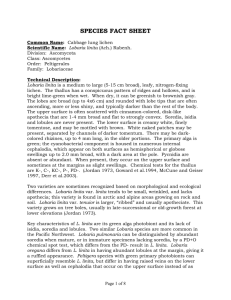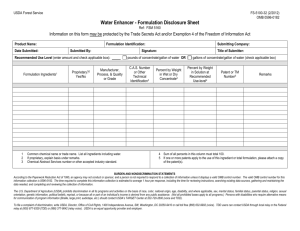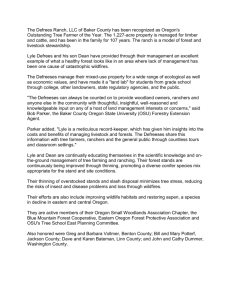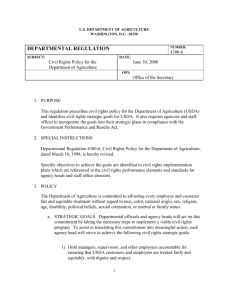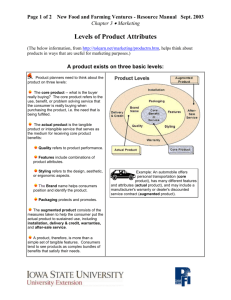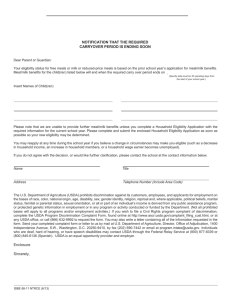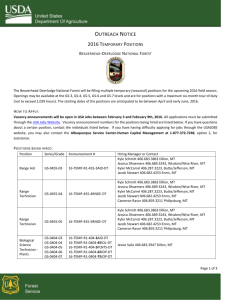Dendriscocaulon intricatulum
advertisement
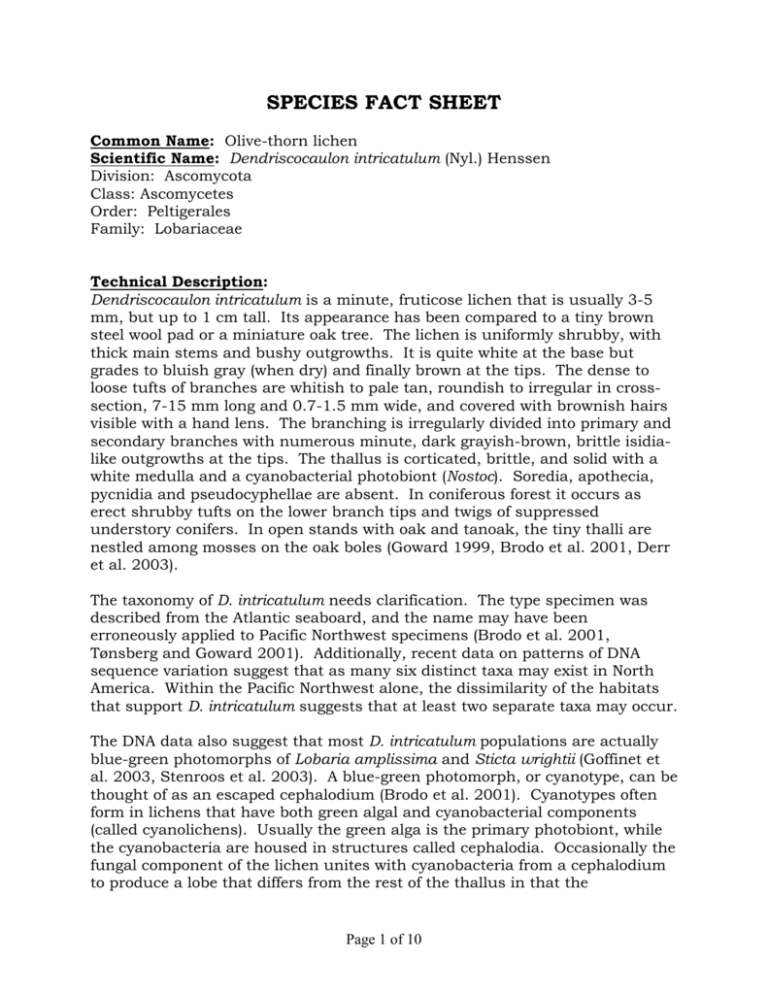
SPECIES FACT SHEET Common Name: Olive-thorn lichen Scientific Name: Dendriscocaulon intricatulum (Nyl.) Henssen Division: Ascomycota Class: Ascomycetes Order: Peltigerales Family: Lobariaceae Technical Description: Dendriscocaulon intricatulum is a minute, fruticose lichen that is usually 3-5 mm, but up to 1 cm tall. Its appearance has been compared to a tiny brown steel wool pad or a miniature oak tree. The lichen is uniformly shrubby, with thick main stems and bushy outgrowths. It is quite white at the base but grades to bluish gray (when dry) and finally brown at the tips. The dense to loose tufts of branches are whitish to pale tan, roundish to irregular in crosssection, 7-15 mm long and 0.7-1.5 mm wide, and covered with brownish hairs visible with a hand lens. The branching is irregularly divided into primary and secondary branches with numerous minute, dark grayish-brown, brittle isidialike outgrowths at the tips. The thallus is corticated, brittle, and solid with a white medulla and a cyanobacterial photobiont (Nostoc). Soredia, apothecia, pycnidia and pseudocyphellae are absent. In coniferous forest it occurs as erect shrubby tufts on the lower branch tips and twigs of suppressed understory conifers. In open stands with oak and tanoak, the tiny thalli are nestled among mosses on the oak boles (Goward 1999, Brodo et al. 2001, Derr et al. 2003). The taxonomy of D. intricatulum needs clarification. The type specimen was described from the Atlantic seaboard, and the name may have been erroneously applied to Pacific Northwest specimens (Brodo et al. 2001, Tønsberg and Goward 2001). Additionally, recent data on patterns of DNA sequence variation suggest that as many six distinct taxa may exist in North America. Within the Pacific Northwest alone, the dissimilarity of the habitats that support D. intricatulum suggests that at least two separate taxa may occur. The DNA data also suggest that most D. intricatulum populations are actually blue-green photomorphs of Lobaria amplissima and Sticta wrightii (Goffinet et al. 2003, Stenroos et al. 2003). A blue-green photomorph, or cyanotype, can be thought of as an escaped cephalodium (Brodo et al. 2001). Cyanotypes often form in lichens that have both green algal and cyanobacterial components (called cyanolichens). Usually the green alga is the primary photobiont, while the cyanobacteria are housed in structures called cephalodia. Occasionally the fungal component of the lichen unites with cyanobacteria from a cephalodium to produce a lobe that differs from the rest of the thallus in that the Page 1 of 10 cyanobacteria, rather than green algae, is the primary photobiont. Cyanotypes can be found growing attached to the parent thallus, or they can separate and be free-living, as appears to be the case in D. intricatulum (Brodo et al. 2001, Derr et al. 2003). Dendriscocaulon intricatulum specimens have also been found to be cyanotypes of other Lobaria species as well as of Pseudocyphellaria and the newly-described species Sticta oroborealis (Tønsberg and Goward 2001, Goffinet et al. 2003). Some authors advocate for dropping the name Dendriscocaulon intricatulum in favor of the names of the parent cyanolichens that generated the cyanotypes (Tønsberg and Goward 2001, Stenroos et al. 2003). However, the cyanotypes are difficult to distinguish morphologically. Until the taxonomy is clarified, all material will be called D. intricatulum for management and species viability concerns (USDA/USDI 2000b, Derr et al. 2003). Several lichens resemble D. intricatulum (Derr et al. 2003). Leptogium teretiusculum is a small gelatinous lichen that is very similar to D. intricatulum, but it is non-stratified and lacks the brown tomentum visible with a hand lens in D. intricatulum. Polychidium contortum also looks like a miniature steel wool pad, but it is translucent blue and has diagnostic jigsaw-shaped cells visible under the light microscope. Sticta oroborealis occurs as an outgrowth of a cephalodium of the thallus of a green-algal Sticta, and is not yet known to occur free-living. Life History: No sexual or asexual reproductive structures are known from Dendriscocaulon intricatulum. The lichen may reproduce asexually through fragmentation, given the brittle nature of the thallus, and the isidia-like outgrowths at the branch tips may function as propagules when detached from the main body. The patchy distribution and rarity of the species suggests that its dispersal may be limited, either by the actual physical migration of propagules or their successful establishment and growth in new habitats (USDA/USDI 2000b, Derr et al. 2003). Range, Distribution, and Abundance: Dendriscocaulon intricatulum is endemic to North America, occurring sporadically from southeastern Alaska through British Columbia, the Washington Cascades, the Siskiyou Mountains in Oregon, and reaching the southern limit of its range in coastal northern California. The species has a moderate geographic range in the Pacific Northwest, with a distribution that is widespread but spotty within this range, and it occurs in isolated site clusters. Populations at individual sites tend to be very small throughout most of the range (USDA/USDI 2000). Page 2 of 10 As of 2004 there were 696 known occurrences within the range of the northern spotted owl, with only 20, or 3%, of these in Congressionally Withdrawn or Late Successional Reserve Land Allocations (USDA/USDI 2004b). The majority (66%) of these sites were from the Oregon Klamath physiographic province, mostly from the Medford District of the BLM (Rittenhouse 2002). An additional 23% were from the Oregon Cascades, 5% from the California Klamath, 4% from the California Cascades, 2% from the Washington Western Cascades, and less than 1% from each of the Washington Eastern Cascades, Oregon Coast Range and California Coast Range provinces (USDA/USDI 2004c). Dendriscocaulon intricatulum is apparently rare in Washington, northern Oregon and northern California, with less than 20 sites occurring in the moist, northern part of its range north of the Willamette National Forest (Rittenhouse 2002, 2003). Only a handful of scattered populations occur in these areas, and there are usually only a few individuals present at a given site (Rittenhouse 2002); however the tiny species may have been overlooked during surveys in suitable habitat (Derr et al. 2003). Known occurrences in Washington are from the Mt. Baker-Snoqualmie and Gifford-Pinchot National Forests and the Columbia River National Scenic Area; in Oregon from moist sites on the Mt. Hood and Willamette National Forests; and in California from the Six Rivers and Shasta-Trinity National Forests (Derr et al. 2003). Despite the rarity of D. intricatulum throughout most of its range, the species has a peak in abundance in Coos, Curry, Douglas, Jackson and Josephine counties, Oregon, where over 200 known sites have been documented. Dendriscocaulon intricatulum can be locally abundant and common in this area, but rapidly dwindles with distance from the population center. It has been suggested that these populations may be a unique taxon (Derr et al. 2003). Habitat Associations: There are three distinct habitat types for Dendriscocaulon intricatulum. However, all three share the features of high humidity and the presence of associated cyanolichens. Cyanolichens, such as Lobaria spp., Nephroma spp., Pseudocyphellaria spp., and Sticta spp., always co-occur with D. intricatulum and are good indicators of potential habitat (Derr et al. 2003). Dendriscocaulon intricatulum appears to be extremely sensitive to air moisture and needs high humidity (Stone 2003). In the northern part of its range, from the Mt. Hood, Willamette, and Gifford Pinchot National Forests north to southeastern Alaska, D. intricatulum is rare and is associated with old-growth and legacy components. In this area it is found in mesic to moist forest in the upper Tsuga heterophylla and lower Abies amabilis Zones in the western Cascades at elevations of 30-2170 ft. It often grows as an epiphyte on the lower twigs of suppressed understory T. heterophylla and A. amabilis, occurring in mature and old-growth Pseudotsuga Page 3 of 10 menziesii, T. heterophylla and A. amabilis forests in both riparian and upland areas. Dendriscocaulon intricatulum occurs in unusual habitat at the Sulfur Creek Lava Flow near Mt. Baker, the site where it was first documented within the Northwest Forest Plan area (Thomas et al. 1993). It occurs at this location in a relatively low-elevation A. lasiocarpa stand among an epiphytic lichen flora that is more typical of P. menziesii stands (Derr et al. 2003). While recorded habitats include open-grown conifer and mixed conifer/deciduous stands with Pinus contorta, P. muricata or Acer macrophyllum, the majority of sites occur in mixed oak/conifer forested communities from the Columbia Gorge south to northern California. The highest concentration of known sites occurs in Josephine and Jackson counties, Oregon. In this area, it is locally abundant and may not be oldgrowth associated (USDA/USDI 2004a). In this area, D. intricatulum has been found on Quercus kelloggii, Q. garryana, Q. chrysolepis, and Lithocarpus densiflora, in stands with a substantial conifer component. In oak habitat, D. intricatulum is most commonly found growing on the boles and larger branches of young Q. kelloggii trees, about 4-6” diameter at breast height, which have developed moderately fissured to platy bark textures (USDA/USDI 2002). It is not found on younger trees with thinner, smoother bark, or on older trees with more deeply fissured bark (Rittenhouse 2002). The key components that comprise suitable habitat in these areas include a) an open understory for good air circulation, b) a Pseudotsuga menziesii canopy for air moisture retention in dry seasons, and c) an understory of Q. garryana or L. densiflora, which provide additional substrate for the lichen. On the Medford District BLM, D. intricatulum is found on the ridges between draws rather than within the draws (Derr et al. 2003). In northern California, several sites are known from the coastal fog zone. Dendriscocaulon intricatulum was found on an open grown A. macrophyllum in an oak woodland, on an oak bald in the fog zone near Eureka, and in the pygmy forest ecosystem, where high humidity results from the effects of coastal fog and frequently saturated soil (Derr et al. 2003). Threats: Major threats include 1) treatments that eliminate local populations by removal of colonized trees; 2) altering the microclimatic conditions through treatments that change the light, moisture or temperature regime of occupied sites; 3) collection of colonized twigs for firewood, particularly on the Horse Mountain site in California; 4) overtopping of oak habitat by encroaching P. menziesii, and 5) deteriorating air quality, especially through increases in sulfur dioxide. Air pollution is presumably a threat to D. intricatulum as it is for other nitrogen-fixing lichens, and areas of severe pollution have no populations (Thomas et al. 1993, USDA/USDI 1994, USDA/USDI 2000a, USDA/USDI 2000b, Stone 2003). Page 4 of 10 Conservation Considerations: Maintain trees with colonies of D. intricatulum. Leave adequate standing trees and understory vegetation adjacent to colonized trees to maintain existing environmental conditions for local populations and to provide substrate for colonization (USDA/USDI 2000b). Maintenance of well-distributed stands of suitable habitat may be important because of the lichen’s apparently limited dispersal ability (USDA/USDI 2000b). During fuels reduction treatments in oak habitat, consider following the specific guidelines for the Oregon Klamath province (excepting Josephine and Jackson counties) in the management recommendation amendments for fuel hazard reduction (USDA/USDI 2002), including: 1) thin at occupied sites only if conifer encroachment threatens the oaks and then only in relatively moist areas where moisture levels do not depend on conifer presence; 2) buffer occupied sites from radiant heat or smoke from broadcast or pile burning; 3) avoid wetting thalli with water, foam or any wetting agent; 4) avoid pruning oaks, or if necessary, ensure no colonized branches are pruned; 5) avoid mechanical damage to colonized oaks through line construction, crushing, chopping, grinding, mowing, chipping or raking. Other pertinent information (includes references to Survey Protocols, etc): Brodo et al. (2001) provide keys that include Dendriscocaulon intricatulum, and Goward (1999) provides a key that includes Sticta oroborealis. Survey protocols (Derr et al. 2003), management recommendations (USDA/USDI 2000b), and amended management recommendations for fuel hazard reduction treatments (USDA/USDI 2002) were developed by the USDA/USDI Survey and Manage Program. The information in this Species Fact Sheet updates some of the information presented in those documents. ATTACHMENTS: (1) References cited (2) Map of known sites in Oregon and Washington (3) Line drawing Preparer: Kimiora Ward Date Completed: April 2006 Revised: Richard Helliwell, March 2007 Page 5 of 10 Attachment 1 – References: Brodo, I.M., S.D. Sharnoff and S. Sharnoff. 2001. Lichens of North America. Yale University Press, New Haven, New Hampshire, USA. 795 p. Derr, C.C., R.D. Lesher, L.H. Geiser and M.M. Stein. 2003. 2003 amendment to the survey protocol for Survey and Manage Category A & C lichens in the Northwest Forest Plan Area, Version 2.1 Amendment. USDA Forest Service Pacific Northwest Region Natural Resources Technical Paper, Portland, OR, R6NR-S&M-TP-09-03. 42 p. Goffinet, B., T. Tønsberg and T. Goward. 2003. Phylogenetic affinities of North American populations of Dendriscocaulon based on inferences from variation in the ITS nrDNA sequences (Abstract). Botany 2003: Meeting of the Botanical Society of America, American Society of Plant Taxonomists, American Bryological and Lichenological Society and American Fern Society. Mobile, Alabama. Available: http://www.2003.botanyconference.org/engine/search/detail.php?aid=116 [Accessed December 20, 2005]. Goward, T. 1999. The lichens of British Columbia, illustrated keys. Part 2, Fruticose species. Victoria, BC, Canada: British Columbia Ministry of Forests Research Program. 319 p. Rittenhouse, B. 2002. Strategic survey implementation guide, version 2.4. Survey and Manage Program, Bureau of Land Management OregonWashington and USDA Forest Service Region 6. Bureau of Land Management, Portland, Oregon, USA. Available: http://www.or.blm.gov/surveyandmanage/ss.htm. (Accessed December 16, 2005). Rittenhouse, B. (Editor). 2003. 2003-2004 Strategic Survey Implementation Guide. Survey and Manage Program, Bureau of Land Management OregonWashington and USDA Forest Service Region 6. Bureau of Land Management, Portland, Oregon, USA. Available: http://www.or.blm.gov/surveyandmanage/ss.htm. (Accessed December 16, 2005). Stenroos, S., E. Stocker-Wörgötter, I. Yoshimura, L. Myllys, A. Thell and J. Hyvönen. 2003. Culture experiments and DNA sequence data confirm the identity of Lobaria photomorphs. Canadian Journal of Botany 81:232-247. Stone, D. 2003. Heritage Rank Status Factors, Dendriscocaulon intricatulum. Oregon Natural Heritage Program, Oregon State University, Corvallis, Oregon, USA. Available: Page 6 of 10 http://oregonstate.edu/ornhic/survey/dendriscocaulon_intricatulum_global.p df. (Accessed December 16, 2005). Thomas, J.W. and others. 1993. Forest ecosystem management: an ecological, economic and social assessment. Report of the Forest Ecosystem Management Assessment Team (FEMAT). USDA, Forest Service, Portland, OR. Available: http://www.or.blm.gov/nwfpnepa/index.htm. Tønsberg, T. and T. Goward. 2001. Sticta oroborealis sp. nov. and other Pacific North American lichens forming dendriscocauloid cyanotypes. The Bryologist 104: 12-23. USDA/USDI. 1994. Final supplemental environmental impact statement on management of habitat for old-growth forest related species within the range of the Northern Spotted Owl: Appendix J2 results of additional species analysis. Portland, Oregon. Available: http://www.or.blm.gov/nwfpnepa/index.htm. USDA/USDI. 2000a. Final supplemental environmental impact statement for amendment to the Survey and Manage, Protection Buffer, and other mitigation measures Standards and Guidelines. Portland, Oregon. Available: http://www.or.blm.gov/nwfpnepa/index.htm. USDA/USDI. 2000b. Management recommendations for Sticta sp. #1 (Goward and Tønsberg in prep.) [formerly Dendriscocaulon intricatulum (Nyl.) Henssen], version 2.0. Survey and Manage Program, Bureau of Land Management Oregon-Washington and USDA Forest Service Region 6. Bureau of Land Management, Portland, Oregon, USA. Available: http://www.or.blm.gov/surveyandmanage/ss.htm. (Accessed December 16, 2005). USDA/USDI. 2002. Survey and Manage management recommendation amendments for fuel hazard reduction treatments around at-risk communities. Group 1 – certain fungi, lichens, bryophytes, vascular plants. Survey and Manage Program, Bureau of Land Management Oregon-Washington and USDA Forest Service Region 6. Bureau of Land Management, Portland, Oregon, USA. Available: http://www.or.blm.gov/surveyandmanage/ss.htm. (Accessed December 16, 2005). USDA/USDI. 2004a. Final supplemental environmental impact statement to remove or modify the Survey and Manage Mitigation Measure Standards and Guidelines. Portland, Oregon. Available: http://www.or.blm.gov/nwfpnepa/index.htm. USDA/USDI. 2004b. Species locations by Land Use Allocation, Annual Species Review, Survey and Manage Program, Bureau of Land Management Oregon-Washington and USDA Forest Service Region 6. Interagency Special Page 7 of 10 Status Species Program, Bureau of Land Management Oregon-Washington and USDA Forest Service Region 6. Bureau of Land Management, Portland, Oregon, USA. Available: http://www.or.blm.gov/ISSSP/AnnualSpeciesReview/2004/Species_Locations _by_LUA.pdf. (Accessed December 16, 2005). USDA/USDI. 2004c. Species locations by physiographic province, Annual Species Review, Survey and Manage Program, Bureau of Land Management Oregon-Washington and USDA Forest Service Region 6. Interagency Special Status Species Program, Bureau of Land Management Oregon-Washington and USDA Forest Service Region 6. Bureau of Land Management, Portland, Oregon, USA. Available: http://www.or.blm.gov/ISSSP/AnnualSpeciesReview/2004/Species_Locations _by_PhysioProv.pdf. (Accessed December 16, 2005). USDA/USDI. 2005. Interagency Special-status and Sensitive Species Program, Bureau of Land Management Oregon-Washington and USDA Forest Service Region 6 [web application]. Bureau of Land Management, Portland, Oregon, USA. Available: http://www.or.blm.gov/ISSSP/. [Accessed: December 19, 2005]. Page 8 of 10 Attachment 2 – Map of Dendriscocaulon intricatulum locations in Oregon and Washington from the GeoBOB database (Oct. 2006) Page 9 of 10 Attachment 3 – Line drawing of Dendriscocaulon intricatulum Dendriscocaulon intricatulum Drawing by Alexander Mikulin Page 10 of 10
